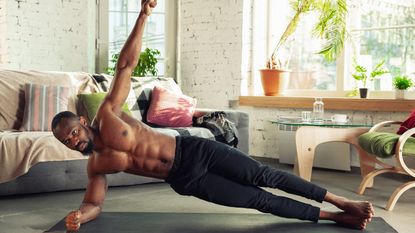

The best core exercises should be one of the first exercises to include in your workout regime because without a strong core; you won't be lifting heavy anytime soon. Training your core can also help improve posture and balance significantly.
Not to mention, getting a six-pack requires frequent abs workouts, and the below core exercises indeed work the abs, obliques and lower back, bulking up your torso in the best way possible.
Not all of the best core exercises are easy, but at least they don't involve investing heavily in the best home workout equipment: most are bodyweight only. However, one of them requires you to use an ab roller and another a pull-up bar or multi-gym, whichever you prefer.
Even the more notorious core exercises have lower impact alternatives: do knee-planks instead of standard planks, put your feet down when doing Russian twists and bend the knees as you lift your legs up when doing kick-ups. Especially if you are unfamiliar with these core exercises, get your muscles ready with the low impact versions.
- The best core exercise has been found using science
- How to build muscle: a guide to muscle building for quicker gains and better results
- 5-minute abs workout
What is 'core' and what is it good for?
Core muscles surround your lower torso and include the abdominal muscles, the obliques and the lower back.
Following a regular core exercise routine has a range of health benefits, apart from giving you the ability to keep your body straight: having a strong core means you can lift heavier in the gym, have better posture when you sit for more extended periods, and it can even alleviate some forms of back pain.
Many people fall into the trap of only training their abs to get a six-pack, but you need to pay attention to your lower back muscles as well if you want to master push-ups. If you struggle to keep your body straight when doing press-ups or having trouble keeping your back straight when you sit, those can all be the signs of a weak core.
Sign up to the T3 newsletter for smarter living straight to your inbox
Get all the latest news, reviews, deals and buying guides on gorgeous tech, home and active products from the T3 experts
Best core exercises
Thread the needle
Thread the needle is a side plank variety but a more active version. Side plank is excellent to strengthen the obliques, but just like planks, it is a bit boring. Thread the needle makes side planks and, therefore, oblique/core training more exciting and dynamic.
To perform the thread the needle exercise, go down in a side plank pose with one hand on the ground, the other one extended towards the ceiling, spine neutral and the legs in front of each other, body kept straight, core engaged. From here, pull the extended arm down and through the hole under your body, rotating the hips but keeping the torso straight, then return to the starting position.
For added difficulty, try stacking your feet on top of each other or hold a dumbbell in your hand. I call the latter version 'shred the needle' as you will get shredded obliques/abs in no time doing it.
Plank
In-depth: How to plank
Planks look simple yet are notoriously hard to perform. In reality, planks are one of the most efficient exercises out there to strengthen your core, not just your abs but also your lower back. Doing planks is your fast track to six-pack gains and definitely a better way than doing crunches alone.
All you have to do is keep your body straight for as long as possible, preferably at least 30 seconds, but feel free to hold it for longer if you can.
Plank varieties include high planks (arms extended, starting position of a pushup), low planks (resting your upper body on your elbows), knee planks (resting your lower body on your knees) and side planks (one arm supporting your upper body, facing sideways).
- 3 plank mistakes you're making (and how to fix them)
Hardstyle plank
In-depth: How to do hardstyle planks
Planks are plenty hard enough for most, but this plank variation cranks up the difficulty level even higher. With the standard plank, you only have to hold the pose for as long as you can, but with a hardstyle plank, you need to flex all the muscles in your body, working them way harder than usual.
From an onlookers point of view, hardstyle plank looks similar to standard planks: you go down on your forearms and toes and hold your body straight, parallel to the ground. The difference with hardstyle plank is that you pull your elbows and toes toward the centre of your body without actually moving them.
Granted, you probably won't be able to hold a hardstyle plank for 40 seconds, but what you can do is hold it for 5-10 seconds first, then gradually increase the length over time. For the rest of the 40-second block, you can hold the standard plank.
Chinese back plank
In-depth: how to do Chinese back planks
Even very muscular people struggle with doing pull-ups: the heavier you get, the more effort it takes to pull yourself over the bar, meaning you will have to do pull-ups to get better at pull-ups. Pull-ups are great, but it takes pretty long to master them, which might put some people off trying to get better at it.
Having said that, there are other ways to train the upper back muscles than pull-ups using bodyweight only. Take, for example, the Chinese back plank. This is not an easy exercise either, but more accessible than pull-ups for sure. Also, instead of mainly training the upper back area, Chinese back planks also strengthen the lower back, which is admittedly part of your core.
As you can see from the video above, you will need to flex all your back, core and leg muscles to hold the Chinese back plank position, even just for a short period. To be on the safe side, try practising Chinese back planks on a slightly elevated surface.
Ab rollout
In depth: how to use an ab roller
Ab rollers are wonderful and if you haven't learned how to use an ab roller yet, it's time to pick up some knowledge. Doing ab rollouts anywhere, let it be the gym or at home, is an absolute power move and the ultimate party trick (along with being able to do pistol squats).
Just like planks, the ab rollout exercise looks pretty simple: hold the roller with your hands, legs bent in the knees, then push the roller forward until your nose almost touches the ground. Once there, pull the roller back towards your knees. Sounds simple enough? It really isn't and we wouldn't recommend it to anyone who hasn't got at least a moderate amount of core strength.
- Ab Carver Pro review: a meaty six pack machine for both beginners and ab workout pros
Mountain climbers
Mountain climbers work pretty much your whole body, but especially your abs and obliques, your quads and hamstrings, and basically your whole upper body for stabilisation.
You start off in the standard push up position. To perform a mountain climber, drive your knees up towards your chest, one at a time, in quick succession. You want to keep your body in a pushup position, all the way through the exercise, so don't bob your hips up and down as you're tucking your legs in.
Try to do mountain climbers as fast as you can without compromising on technique. It is a high-intensity exercise, after all. You'll see that even 15 seconds of mountain climbers can be very tiring.
Russian twist
To perform a proper Russian twist, sit down on the floor with your legs extended in front of you. Clasp your hand together and lift your feet off the ground, using your core to balance.
Then, turn your shoulders and move your fists from one side of your body to the other, over your knees. A variety on the theme is to touch the floor on both sides as you twist your body, your hands doing a semi-circle over your knees.
For added resistance, you can hold either the best dumbbell or the best kettlebell in your hands as you twist.
Superman
Superman is a great bodyweight exercise to work your lower back. The only item you might need is the best yoga mat to lay it down on the floor, especially if you are working out on a hard floor.
To perform a superman, lay down on the mat with your arm extended over your head, the whole body relaxed, spine neutral. It's essential to keep the spine in a neutral position all the way through the movement: don't try to look up as you lift your arms and legs off the floor.
Before you lift your limbs off the floor, engage your and and your glutes and lift your arms and legs off the floor. You don't want to pull them back, only up as far as you can. Focus on your back and lower your limbs if you feel too much pressure.
The idea here is to activate the lower back muscles and they won't be activated more by trying to fold yourself back in half. Even if you 'just' hover your limbs above the ground for a longer period than just half a second, it should work the lower back just fine.

Matt Kollat is a journalist and content creator who works for T3.com and its magazine counterpart as an Active Editor. His areas of expertise include wearables, drones, fitness equipment, nutrition and outdoor gear. He joined T3 in 2019. His byline appears in several publications, including Techradar and Fit&Well, and more. Matt also collaborated with other content creators (e.g. Garage Gym Reviews) and judged many awards, such as the European Specialist Sports Nutrition Alliance's ESSNawards. When he isn't working out, running or cycling, you'll find him roaming the countryside and trying out new podcasting and content creation equipment.
-
 The iPad just dropped to its lowest-ever price – this is a 5-star Apple deal
The iPad just dropped to its lowest-ever price – this is a 5-star Apple dealYou can get your hands on Apple's entry-level tablet for just over $250
By Britta O'Boyle Published
-
 Award-winning Sonos speaker gets huge Black Friday price cut
Award-winning Sonos speaker gets huge Black Friday price cutSave 20% on the Sonos Move 2 at Amazon
By Yasmine Crossland Published